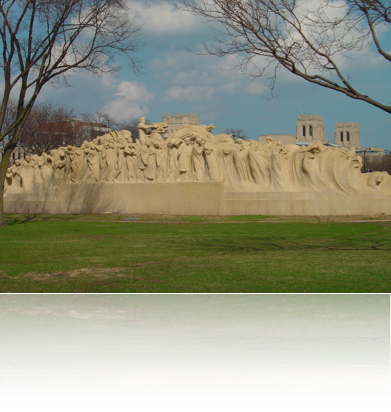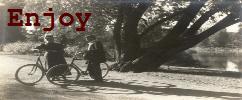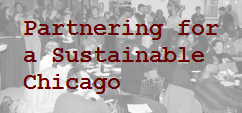
A Short History
The South Side’s park system is older than most of its neighborhoods. The creation and management of both large-scale and neighborhood parks has been intimately connected to social change throughout the history of the South Side down to today.
In 1869, the city purchased a vast swath of undeveloped land between Lake Michigan and what would later become King Drive, placing it under the jurisdiction of the South Park Commission. Famed landscape architect Frederick Law Olmsted was hired to turn the rough countryside into a showpiece leisure and recreation ground for the growing city. Jackson Park, the Midway Plaisance, and Washington Park all came from the 1055 acres of the original South Park. At Olmsted’s direction, the low and swampy land was studded with trees, landscape features, bridle paths, and meandering carriage lanes. In the 1870’s, urban park designers intended parks to be grounds for relaxation and enjoyment by a city’s elite, and the big South Side parks were no exception. Proponents also argued that building parks led to faster residential development and higher home prices.
The World’s Columbian Exposition of 1893 spurred rapid development across the South Side. The Midway and Jackson Park housed the famous scientific and cultural exhibits, live entertainment, and games. Most of the Exposition’s buildings were temporary, but a few were permanent, most notably the building that became the Museum of Science and Industry. Washington Park, while not the center of the Exposition, drew considerable attention and improvement as well.
By the early 20th century, the Olmsted-designed South Side parks were classics of the grand style of American urban parks. Washington Park featured a lagoon for boating, an archery range, a botanical conservatory (like those in Lincoln and Garfield Parks, although the Washington Park conservatory was later torn down), and huge sculptures made of plants. After the elevated train (now the Green Line) reached the park and beyond, the park was easily accessible to patrons from all over the city. A more working- and middle-class element came to rely on the park for fresh air, leisure, and sports. Baseball began to replace the statelier pastimes of strolling and carriage touring. Bicycles became another force for democratizing the park, as they came to share the roads with carriages in the middle 1890’s. Not long after, the automobile replaced them both.
Urban reformers came to see parks as the answer to all kinds of social ills, from juvenile delinquency to poor health, resulting in a proliferation of small parks and playgrounds aimed at alleviating the slum conditions of the city’s working class neighborhoods. Like the larger parks, prominent landscape designers created many of these smaller parks. Armour Square in Bridgeport is an excellent example of this style. On hot summer nights, the city’s apartments emptied into the parks so families could sleep on the cool grass.
The South Side’s parks framed both conflict and cooperation along ethnic and racial lines. The brutal race riots of 1919 started on a South Side public beach and raged in and around Washington Park. The city’s burgeoning African American population eventually overcame their informal exclusion from Washington Park and the real and threatened violence that sustained that exclusion. For a many years, in fact, Washington Park was relatively integrated. In the 1950s when swimming pools and dance floors were strictly segregated in many places, photos of Washington Park show it to have been something of an exception.
As time went on and racial succession transformed South Side neighborhoods, the parks informally resegregated. The Chicago Park District (the successor to the regional park commissions of the 19th century) became famous for patronage and neglect, especially in heavily black neighborhoods. As air conditioning helped Chicagoans to stay indoors, the interstate system allowed them to leave town easily, and rising crime and fears of racial violence kept citizens away from public spaces, the parks lost some of their prominence in city life. In the 1980’s, Mayor Harold Washington wrested control of the parks from old machine hands, increasing local oversight and participation in the management of the parks. The younger Mayor Daley cut staff while keeping overall park spending high. As crime has fallen, the large South Side parks are seeing more visitors. Washington and Jackson parks are home to many family reunions throughout the summer months. Today Washington Park is fringed by some of the South Side’s fastest-rising home prices as gentrification reaches into long-neglected neighborhoods. As the city looks to Washington Park for the site of the 2016 Olympic Games’ stadium, some residents fear displacement.
Further Reading:
Julia Bachrach, The City in a Garden: a Photographic History of Chicago’s Parks (Placitas, NM: Center for American Places, in association with the Chicago Park District, 2001)
Gerald R. Gems, Windy City Wars: Labor, Leisure, and Sport in the Making of Chicago (Lanham, Md.: Scarecrow Press, 1997)
John Graf, Chicago’s Parks (Chicago: Arcadia, 2000)
William W. Tippens and Edward K. Uhlir, “Urban Park Reform in the Chicago South Park Commission,” Threshold, Fall 1991.
Parks

Learn More


uchicago®  ©2007 The University of Chicago®
©2007 The University of Chicago®  5801 South Ellis Ave., Chicago, IL 60637
5801 South Ellis Ave., Chicago, IL 60637  773-702-1234
773-702-1234
 ©2007 The University of Chicago®
©2007 The University of Chicago®  5801 South Ellis Ave., Chicago, IL 60637
5801 South Ellis Ave., Chicago, IL 60637  773-702-1234
773-702-1234 



Image sources
Swimming Kids: Library of Congress, Prints & Photographs Division, FSA/OWI Collection, LC-USF33-016071-M1 (b&w film nitrate neg.)